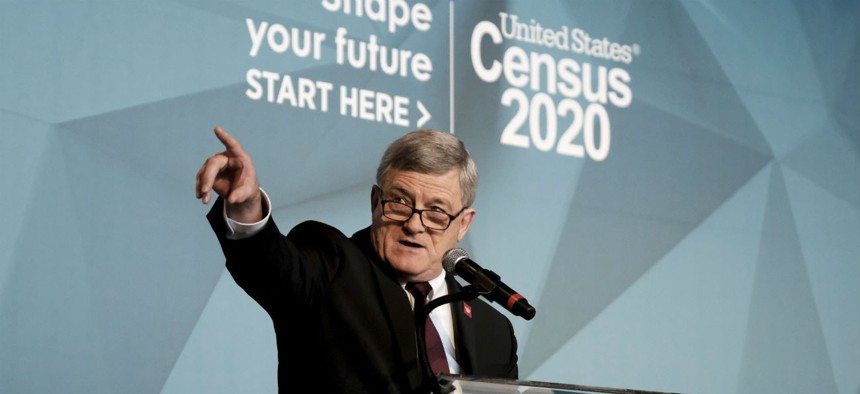
Census Director Steven Dillingham unveils the bureau's national advertising and outreach campaign for the 2020 Census on Tuesday. Michael A. McCoy / AP
Census Is Now Fielding 25K Job Applications Per Day
Despite some early setbacks, Census says its hiring efforts will prove "swimmingly successful."
The U.S. Census Bureau is fielding 25,000 job applications a day as it gears up for a massive hiring spree in the early spring, and agency officials are confident they will meet all their staffing targets in preparation for the decennial count.
As Census prepares to formally kick off the count next week when bureau Director Steven Dillingham travels to Toksook, Alaska, to join staff on the ground there to conduct the first enumeration in the country, the agency said it is in on track to meet its hiring goal of up to 500,000 temporary workers. Census has already received 1.7 million applications, but still needs almost 1 million more. Its 248 Area Census Offices are fully staffed with management and support employees, and the bureau has hired an additional 1,500 partnership specialists and 5,000 recruiters.
Census will begin hiring the bulk of its temporary staff—the census takers—in March, said Tim Olson, the bureau’s associate director for field operations, during a media event in Washington on Tuesday. He added that given the rate at which applications are currently coming in, he expects the agency will already have enough applicants in the queue at that time. The only qualifications for Census applicants is that they are at least 18 years old, U.S. citizens and pass a background check.
The background checks have caused some difficulties for Census, which has faced longer-than-expected wait times, creating a backlog for applicants. Census has tasked temporary workers with moving applicants through the screening faster. Olson suggested Census will have an easier time with its forthcoming hires, as the background check process is a simple fingerprint.
“In five-to-10 minutes we know they’re cleared,” Olson said. “We can onboard them in literally a number of days.”
While Olson on Tuesday predicted the hiring process will be “swimmingly successful,” a Commerce Department inspector general report in November found Census’ recruiting, hiring and payroll systems were not prepared for the demands that will be placed on them as they process more than 2 million applications. Testing failures were so severe, the IG said, that they “present a risk to the successful completion of the 2020 Census program.” The bureau disagreed with the IG’s findings and said its systems will deploy successfully.
Census is also facing pressure to shore up its background check process. Last year, it hired an employee in a Charlotte regional office who was convicted in 2013 on felony misconduct involving a child. He was again arrested for sexual misconduct with a child two months later. The Commerce IG called on Census to add additional layers of review to ensure suitability determinations are made appropriately.
Census this year will aim to compel U.S. residents to complete the survey by focusing on the importance of its findings to every community. The bureau has hired the marketing firm VLMY&R, which itself has a team of 14 subcontractors, to create an array of advertising materials. It has already put together 1,000 ads, or six hours of video. The platforms on which ads are set to deploy range from television to billboards to gas station pumps, officials said. The bureau is using the slogan, “Shape your future. Start here.”
The ads will reach 99% of Americans, said Dillingham, the bureau’s director. They will air in 13 languages, though Census will conduct outreach in many more. More than one in five applicants in its current pool are bilingual, and collectively they speak 420 languages.
Census recently began the “awareness phase” of its marketing effort, which will focus on explaining to Americans why the survey is important. In a couple months, it will move to the “motivation phase,” during which it will instruct Americans on how to fill out the form. It will finally move to the “reminder phase” when it will stress the urgency of completing the questionnaire.
Respondents for the first time ever will have the option of answering online, which is how the bureau expects 60-65% of residents to submit their information. After five mailings, Census will deploy enumerators to knock on doors at households that have not responded. A Census contractor has already completed printing 120 million paper forms and has the capacity to produce more if necessary. Dillingham called the new technology a “quantum leap” for the agency.
Census has also ramped up its partnership efforts, relying on tribal, state and local governments, as well as non-profit groups, to spread the word about the survey. The bureau has already set up 8,000 “complete count committees” around the country to get assistance from local leaders, Dillingham said, and that number continues to grow. More than 200,000 Census sponsors have held events to promote the survey. The bureau is even relying on kids to get their parents to fill out the form: it has partnered with state departments of education and local school boards to expand its Statistics in Schools program to stress the importance of the Census and to remind schoolchildren to tell their parents to complete the survey.







